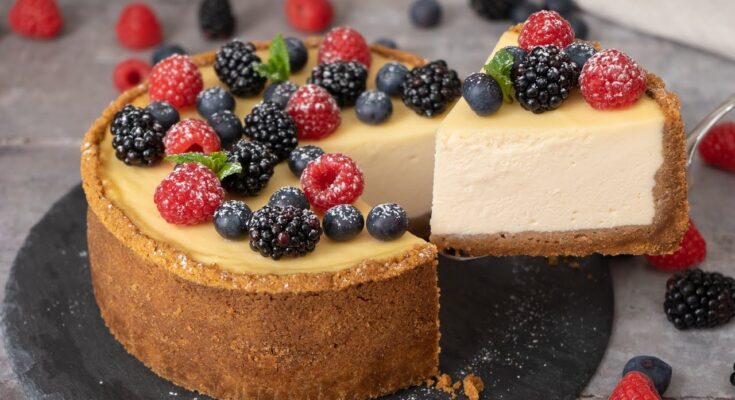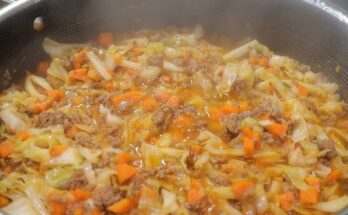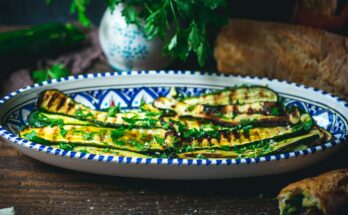Best Cheesecake Recipe: Cheesecake is one of the most beloved desserts worldwide, celebrated for its rich, creamy texture and versatile flavors. Whether you’re indulging in a New York-style cheesecake or a fruity no-bake version, this dessert never fails to impress. What makes it even more special is its adaptability—perfect for birthdays, holidays, and even casual get-togethers.
Types of Cheesecakes Around the World
- New York-Style Cheesecake – Dense, rich, and smooth, often baked in a water bath.
- Japanese Cheesecake – Light and fluffy, resembling a soufflé.
- No-Bake Cheesecake – Creamy and quick, set in the refrigerator without baking.
- Ricotta Cheesecake (Italian) – Made with ricotta cheese for a lighter texture.
In this guide, we’ll walk you through the process of making the best classic baked cheesecake step-by-step so that even beginners can achieve bakery-quality results.
Ingredients Required for the Perfect Cheesecake
Key Ingredients for Crust
- Graham Crackers – Crushed into fine crumbs (approximately 1 ½ cups).
- Butter – Melted, about ½ cup.
- Sugar – 2 tablespoons for added sweetness.
Key Ingredients for Filling
- Cream Cheese – 4 packages (8 oz each), softened.
- Granulated Sugar – 1 cup, for sweetness.
- Sour Cream – 1 cup, adds creaminess.
- Vanilla Extract – 2 teaspoons, for flavor enhancement.
- Eggs – 4 large eggs, room temperature.
Optional Toppings
- Fresh fruits (strawberries, blueberries, or raspberries).
- Chocolate ganache or caramel sauce.
- Whipped cream for decoration.
Tools and Equipment Needed
Essential Tools for Preparation
- Mixing bowls (large and medium).
- Electric mixer or stand mixer.
- Rubber spatula for scraping.
- Measuring cups and spoons.
Baking Equipment Checklist
- Springform pan (9-inch recommended).
- Parchment paper for lining the pan.
- Aluminum foil for wrapping the pan.
- Roasting pan for the water bath.
Having these tools ready makes the entire process smooth and stress-free.
Preparing the Crust
Step 1: Choosing the Right Crust Ingredients
The foundation of any great cheesecake starts with a perfect crust. Graham crackers are the traditional base, but alternatives like Oreo cookies or digestive biscuits can add unique flavors.
Step 2: Mixing and Pressing the Crust
- Crush the crackers – Use a food processor to grind them into fine crumbs.
- Combine ingredients – Mix the crumbs with melted butter and sugar in a bowl until evenly coated.
- Press into the pan – Firmly press the mixture into the bottom of a greased springform pan, creating an even layer.
- Pre-bake the crust – Bake at 325°F (160°C) for 10 minutes, then let it cool completely.
This step prevents a soggy base and creates a crunchy foundation for the filling.
Preparing the Cheesecake Filling
Step 1: Creaming the Base
- Soften the cream cheese – Allow it to reach room temperature for smoother blending.
- Beat the cream cheese – Use a mixer at medium speed until smooth and creamy, about 2-3 minutes.
- Add sugar gradually – Continue mixing until fully dissolved.
Step 2: Mixing Eggs and Flavorings
- Add eggs one at a time – Beat on low speed to avoid incorporating too much air, which can cause cracks.
- Incorporate sour cream and vanilla – Mix until just combined.
Pro Tip: Avoid overmixing, as it can lead to air bubbles and cracks during baking.
Assembling the Cheesecake
Step 1: Layering the Crust and Filling
Once the crust has cooled, it’s time to add the creamy cheesecake filling. Pour the prepared filling over the crust, spreading it evenly with a spatula. Tap the pan gently on the counter to release any trapped air bubbles.
Step 2: Smoothening the Surface
Use a spatula to level the top of the cheesecake, ensuring a smooth and polished surface. This step is crucial for an even bake and professional appearance.
Pro Tip: Avoid overhandling the batter at this stage to prevent cracks during baking.
Baking the Cheesecake
Water Bath Method Explained
The secret to a perfectly baked cheesecake lies in a water bath (also called a bain-marie). This method helps maintain moisture in the oven and prevents cracks.
How to Set Up a Water Bath:
- Wrap the springform pan in two layers of heavy-duty aluminum foil to prevent water from seeping in.
- Place the pan in a large roasting pan.
- Fill the roasting pan with hot water, ensuring it reaches halfway up the sides of the springform pan.
Baking Tips for a Crack-Free Cheesecake
- Preheat the oven to 325°F (160°C).
- Bake the cheesecake for 60–70 minutes. The edges should be set while the center remains slightly jiggly.
- Turn off the oven and leave the cheesecake inside for 1 hour with the door slightly ajar. This gradual cooling prevents sudden temperature changes that cause cracks.
Cooling and Chilling the Cheesecake
Proper Cooling Techniques
After removing the cheesecake from the oven, let it cool to room temperature on a wire rack. Cooling it slowly helps prevent cracks and ensures a smooth texture.
Refrigeration Tips for Firmness
- Cover the cheesecake with plastic wrap and refrigerate it for at least 4–6 hours, or preferably overnight.
- Chilling allows the flavors to meld and the texture to firm up beautifully.
Pro Tip: Never skip the chilling step—it’s what transforms a soft filling into a rich, creamy delight!
Decorating and Serving the Cheesecake
Creative Toppings and Presentation Ideas
Once the cheesecake is chilled, it’s time to decorate it. Here are some ideas:
- Fresh Fruit: Top with strawberries, raspberries, or blueberries for a fresh look.
- Sauces: Drizzle chocolate ganache, caramel, or berry compote for extra indulgence.
- Whipped Cream: Pipe whipped cream around the edges for elegance.
- Nuts and Chocolate Chips: Sprinkle crushed nuts or mini chocolate chips for added texture.
Tips for Perfect Slicing
- Use a sharp knife, and dip it in warm water before slicing to get clean cuts.
- Wipe the knife after each slice for neat presentation.
Pro Tip: Serve each slice with a garnish for an Instagram-worthy dessert!
Common Mistakes and Troubleshooting
Over-Baking Issues
Problem: Cheesecake is dry and crumbly.
Solution: Reduce baking time and check for doneness earlier. Look for slight jiggle in the center.
Cracks and Texture Problems
Problem: Cracks form on the surface.
Solution: Always use a water bath and avoid overmixing the batter. Gradual cooling also helps prevent cracks.
Problem: Dense or lumpy texture.
Solution: Ensure all ingredients, especially cream cheese and eggs, are at room temperature before mixing.
Pro Tip: Minor cracks can be hidden with toppings like whipped cream or fruit!
Variations and Flavor Ideas
Fruity Cheesecake Variations
- Strawberry Swirl Cheesecake – Add strawberry puree and swirl it into the filling before baking.
- Lemon Cheesecake – Incorporate lemon juice and zest for a zesty twist.
- Mango Cheesecake – Layer with mango puree for tropical vibes.
Chocolate and Nut-Based Cheesecakes
- Chocolate Marble Cheesecake – Blend melted chocolate into part of the batter and swirl it in.
- Peanut Butter Cheesecake – Add peanut butter and chocolate chips for a nutty delight.
- Salted Caramel Cheesecake – Top with caramel sauce and sea salt for a rich, savory flavor.
No-Bake Cheesecake Recipe
Quick and Easy Alternative
If you’re short on time, a no-bake cheesecake is a fantastic option.
Ingredients:
- 1 ½ cups graham cracker crumbs
- ½ cup melted butter
- 16 oz cream cheese, softened
- 1 cup powdered sugar
- 1 cup heavy cream, whipped
- 1 teaspoon vanilla extract
Instructions:
- Prepare the crust as described earlier and refrigerate for 30 minutes.
- Beat cream cheese and sugar until smooth. Add vanilla extract.
- Gently fold in whipped cream until combined.
- Pour the filling over the crust and smooth the top.
- Refrigerate for at least 4 hours before serving.
This no-bake version is just as creamy and satisfying but requires no oven time.
Storage and Freezing Tips
Short-Term Storage Options
Cheesecake can be stored in the refrigerator for up to 5 days. Cover it with plastic wrap or aluminum foil to keep it from drying out or absorbing other odors from the fridge.
Pro Tip: Store slices in airtight containers for added freshness.
Freezing Cheesecake for Longer Shelf Life
If you need to keep your cheesecake for longer, freezing is an excellent option.
Steps to Freeze Cheesecake:
- Let the cheesecake cool completely and chill it in the refrigerator overnight.
- Wrap the cheesecake (whole or in slices) in plastic wrap, followed by a layer of aluminum foil.
- Place it in a freezer-safe bag or airtight container.
Shelf Life in Freezer:
- Cheesecake can be frozen for up to 2 months without losing its flavor or texture.
Thawing Tips:
- Transfer the cheesecake to the refrigerator 6–8 hours before serving to allow gradual thawing.
Healthier Cheesecake Alternatives
Low-Sugar and Gluten-Free Recipes
For a lighter cheesecake, substitute traditional ingredients with healthier options:
- Crust Alternatives: Use almond flour or crushed nuts instead of graham crackers.
- Sweeteners: Replace sugar with honey, stevia, or maple syrup.
- Dairy Alternatives: Opt for Greek yogurt or reduced-fat cream cheese to lower calories.
Vegan Cheesecake Options
A vegan cheesecake can be just as creamy and delicious as the classic version.
Ingredients:
- Crust: Blended dates and nuts.
- Filling: Cashews soaked overnight, blended with coconut cream and maple syrup.
- Toppings: Fresh berries or vegan chocolate drizzle.
Pro Tip: Use agar-agar (plant-based gelatin) to set the filling firmly.
FAQs about Best Cheesecake Recipe
What are the key ingredients for making the best cheesecake?
The essential ingredients for a classic cheesecake include cream cheese, sugar, eggs, and a crust made from graham crackers or cookies. For enhanced flavor, you can add vanilla extract or the zest of a lemon.
How long should I bake my cheesecake?
Baking times can vary, but generally, a cheesecake should bake for about 50 to 60 minutes at 325°F (163°C). It’s crucial to avoid overbaking; the center should still be slightly wobbly when you remove it from the oven.
Should I use a water bath for cheesecake?
Using a water bath helps to evenly distribute heat and prevent cracking on the surface of your cheesecake. It also keeps the oven moist, ensuring a smooth and creamy texture.
Can I make cheesecake without a springform pan?
Yes, you can use a regular cake pan lined with parchment paper for easy removal, though a springform pan is ideal for easy unmolding without damaging the cheesecake.
What is the best way to prevent cracks in my cheesecake?
Avoid overmixing the batter, as this can incorporate too much air and lead to cracking. Also, allow the cheesecake to cool gradually in the oven with the door slightly open to minimize temperature shock.
How long does cheesecake need to chill before serving?
Chill your cheesecake in the refrigerator for at least four hours, but ideally overnight. This step is crucial for the cheesecake to set properly and develop the best texture.
Can cheesecake be frozen for later use?
Absolutely! Cheesecake freezes exceptionally well. Wrap the cheesecake tightly in plastic wrap and then aluminum foil before freezing to maintain its flavor and texture. It can be stored in the freezer for up to three months.
Conclusion
Cheesecake is the ultimate dessert that combines elegance and indulgence in every bite. Whether you stick with the classic New York-style or experiment with fruity, nutty, or no-bake variations, this step-by-step guide ensures you can create a flawless cheesecake at home. With helpful tips for baking, decorating, and storing, this recipe is perfect for all occasions—from intimate family dinners to festive celebrations.
Now that you’ve mastered the art of making cheesecake, why not get creative with different flavors and toppings? Remember, baking is as much about having fun as it is about following instructions. So, preheat your oven, grab your ingredients, and start baking today!



